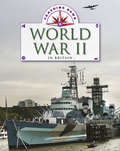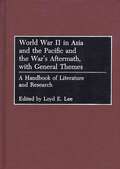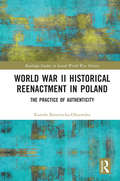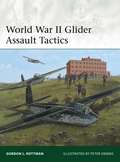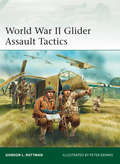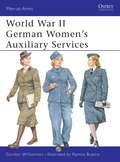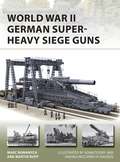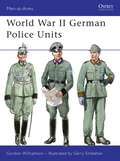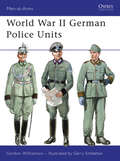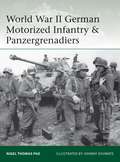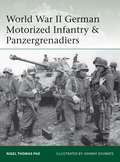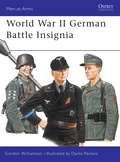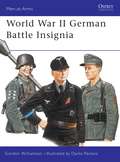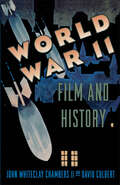- Table View
- List View
World War II in Britain: World War Ii In Britain (Tracking Down #13)
by Liz Gogerly'The past is all around us, if we know where to look.' This series takes a look at archaeological, structural and museum evidence from around Britain, allowing readers to build up a picture of what life was like in key historical periods and how you can discover it for yourself by visiting sites around the country.
World War II in Asia and the Pacific and the War's Aftermath, with General Themes: A Handbook of Literature and Research
by Loyd LeeA companion to World War II in Europe, Africa, and the Americas, this volume reevaluates the most enduring literature on basic aspects of the war in Asia and the Pacific. It also covers themes pertaining to societies at war, culture, the arts, and science and technology as well as international relations and the postwar world. Included are not only grand strategy, military and naval campaigns, and matters of diplomacy, but also resistance, collaboration, prisoners of war, and broad topics of the home front, including chapters on gender issues, film, literature, popular culture, and propaganda. This volume and its companion provide the first comprehensive historiographic reference work on the war.Each chapter describes the state of knowledge on the topic, relating each bibliographic reference to the chapter's themes and issues, and concludes with a bibliography. Recent original scholarship is included when it aids new understanding, and older works of enduring value also find a place. The essays in this volume will interest scholars and college teachers as well as advanced students and serious amateurs seeking insight into the history of the war and its literature.
World War II Historical Reenactment in Poland: The Practice of Authenticity (Routledge Studies in Second World War History)
by Kamila Baraniecka-OlszewskaThis book explores the consequences of the latest political shifts in Central Eastern Europe: the rise of right-wing parties and, among other things, politics becoming more invested in history. These phenomena coincide and overlap with the democratisation of history by turning the past into a hot topic, persistently present in the public sphere and often evoking strong emotions. Ethnographic research (conducted in 2012-2016) focusing on how World War II reenactors experience the past serves as the basis to analyse the ways in which the group uses the widespread, often institutionalised interest in history to – on the one hand – become involved in debates on World War II and the remembrance thereof, and – on the other – to authentically experience this past. The volume therefore analyses how physical the process of creating and experiencing grassroots visions of the past is, and how these visions interact with the public discourse about the past. Reenactors’ ability to marry the often-contradictory orders of historical truth, authenticity, and representation is explored. Moreover, Baraniecka-Olszewska analyses how the reenactors overcome various obstacles on their way towards authentic experiences, performing history through their bodies.
World War II Historical Reenactment in Poland: The Practice of Authenticity (Routledge Studies in Second World War History)
by Kamila Baraniecka-OlszewskaThis book explores the consequences of the latest political shifts in Central Eastern Europe: the rise of right-wing parties and, among other things, politics becoming more invested in history. These phenomena coincide and overlap with the democratisation of history by turning the past into a hot topic, persistently present in the public sphere and often evoking strong emotions. Ethnographic research (conducted in 2012-2016) focusing on how World War II reenactors experience the past serves as the basis to analyse the ways in which the group uses the widespread, often institutionalised interest in history to – on the one hand – become involved in debates on World War II and the remembrance thereof, and – on the other – to authentically experience this past. The volume therefore analyses how physical the process of creating and experiencing grassroots visions of the past is, and how these visions interact with the public discourse about the past. Reenactors’ ability to marry the often-contradictory orders of historical truth, authenticity, and representation is explored. Moreover, Baraniecka-Olszewska analyses how the reenactors overcome various obstacles on their way towards authentic experiences, performing history through their bodies.
World War II Glider Assault Tactics (Elite)
by Peter Dennis Gordon L. RottmanMilitary gliders came of age in World War II, when glider assault infantry were the forerunners of today's helicopter-delivered airmobile troops. From the light pre-war sports and training machines, several nations developed troop-carrying gliders capable of getting a whole squad or more of infantry, with heavy weapons, onto the ground quickly, with the equipment that paratroopers simply could not carry. They made up at least one-third of the strength of US, British, and German airborne divisions in major battles, and they also carried out several daring coup de main raids and spearhead operations. However, the dangers were extreme, the techniques were difficult, the losses were heavy (particularly during night operations), and the day of the glider assault was relatively brief. This book explains the development and organization of glider troops, their mounts, and the air squadrons formed to tow them, the steep and costly learning-curve and the tactics that such troops learned to employ once they arrived on the battlefield.
World War II Glider Assault Tactics (Elite)
by Peter Dennis Gordon L. RottmanMilitary gliders came of age in World War II, when glider assault infantry were the forerunners of today's helicopter-delivered airmobile troops. From the light pre-war sports and training machines, several nations developed troop-carrying gliders capable of getting a whole squad or more of infantry, with heavy weapons, onto the ground quickly, with the equipment that paratroopers simply could not carry. They made up at least one-third of the strength of US, British, and German airborne divisions in major battles, and they also carried out several daring coup de main raids and spearhead operations. However, the dangers were extreme, the techniques were difficult, the losses were heavy (particularly during night operations), and the day of the glider assault was relatively brief. This book explains the development and organization of glider troops, their mounts, and the air squadrons formed to tow them, the steep and costly learning-curve and the tactics that such troops learned to employ once they arrived on the battlefield.
World War II German Women’s Auxiliary Services (Men-at-Arms #393)
by Ramiro Bujeiro Gordon WilliamsonUnder the Nazi regime, Hitler's conservative views on the place of housewives and mothers in society limited German women to a much less active role in the war than their British and Allied counterparts. Nevertheless, the demands of a prolonged war did see German women in a range of uniforms as auxiliaries with the Army, Navy, Air Force and SS, particularly in the signals and air defence services. This unique book explains and illustrates these organisations and their uniforms and insignia, as well as Red Cross nurses, and auxiliaries of the Labour Corps, Customs Service, National Socialist Women's Organisation, and League of German Maidens (Hitler Youth).
World War II German Women’s Auxiliary Services (Men-at-Arms #393)
by Ramiro Bujeiro Gordon WilliamsonUnder the Nazi regime, Hitler's conservative views on the place of housewives and mothers in society limited German women to a much less active role in the war than their British and Allied counterparts. Nevertheless, the demands of a prolonged war did see German women in a range of uniforms as auxiliaries with the Army, Navy, Air Force and SS, particularly in the signals and air defence services. This unique book explains and illustrates these organisations and their uniforms and insignia, as well as Red Cross nurses, and auxiliaries of the Labour Corps, Customs Service, National Socialist Women's Organisation, and League of German Maidens (Hitler Youth).
World War II German Super-Heavy Siege Guns (New Vanguard)
by Marc Romanych Martin RuppAs the outbreak of World War II approached, Nazi Germany ordered artillery manufacturers Krupp and Rheimetall-Borsig to build several super-heavy siege guns, vital to smash through French and Belgian fortresses that stood in the way of the Blitzkrieg. These 'secret weapons' were much larger than the siege artillery of World War I and included the largest artillery piece of the war, the massive 80cm railway gun 'schwere Gustav' (Heavy Gustav). However, these complex and massive artillery pieces required years to build and test and, as war drew near, the German High Command hastily brought several WWI-era heavy artillery pieces back into service and then purchased, and later confiscated, a large number of Czech Skoda mortars. The new super siege guns began entering service in time for the invasion of Russia, notably participating in the attack on the fortress of Brest-Litovsk. The highpoint for the siege artillery was the siege of Sevastopol in the summer of 1942, which saw the largest concentration of siege guns in the war. Afterwards, when Germany was on the defensive in the second half of 1943, the utility of the guns was greatly diminished, and they were employed in a piecemeal and sporadic fashion on both the Eastern and Western Fronts. In total, the German Army used some 50 siege guns during World War II, far more than the thirty-five it had during World War I. Supported by contemporary photographs and detailed artwork of the guns and their components, this is an essential guide to these guns, exploring their history, development, and deployment in stunning detail.
World War II German Super-Heavy Siege Guns (New Vanguard #280)
by Marc Romanych Martin RuppAs the outbreak of World War II approached, Nazi Germany ordered artillery manufacturers Krupp and Rheimetall-Borsig to build several super-heavy siege guns, vital to smash through French and Belgian fortresses that stood in the way of the Blitzkrieg. These 'secret weapons' were much larger than the siege artillery of World War I and included the largest artillery piece of the war, the massive 80cm railway gun 'schwere Gustav' (Heavy Gustav). However, these complex and massive artillery pieces required years to build and test and, as war drew near, the German High Command hastily brought several WWI-era heavy artillery pieces back into service and then purchased, and later confiscated, a large number of Czech Skoda mortars. The new super siege guns began entering service in time for the invasion of Russia, notably participating in the attack on the fortress of Brest-Litovsk. The highpoint for the siege artillery was the siege of Sevastopol in the summer of 1942, which saw the largest concentration of siege guns in the war. Afterwards, when Germany was on the defensive in the second half of 1943, the utility of the guns was greatly diminished, and they were employed in a piecemeal and sporadic fashion on both the Eastern and Western Fronts. In total, the German Army used some 50 siege guns during World War II, far more than the thirty-five it had during World War I. Supported by contemporary photographs and detailed artwork of the guns and their components, this is an essential guide to these guns, exploring their history, development, and deployment in stunning detail.
World War II German Police Units (Men-at-Arms)
by Gerry Embleton Gordon WilliamsonThe German Police were an essential arm of the Nazi regime; as soon as Hitler achieved power the previous decentralized provincial system was unified into a single state apparatus, integrated at the command levels with the SS. While it may have been centrally controlled, it was still separated into a bewildering range of different departments and functions, many with their own uniform distinctions. This book offers a concise introduction to the organization, responsibilities, uniforms and insignia of the various branches of this machinery of repression, from Police generals to rural constables, transport policemen and factory watchmen.
World War II German Police Units (Men-at-Arms #434)
by Gordon WilliamsonThe German Police were an essential arm of the Nazi regime; as soon as Hitler achieved power the previous decentralized provincial system was unified into a single state apparatus, integrated at the command levels with the SS. While it may have been centrally controlled, it was still separated into a bewildering range of different departments and functions, many with their own uniform distinctions. This book offers a concise introduction to the organization, responsibilities, uniforms and insignia of the various branches of this machinery of repression, from Police generals to rural constables, transport policemen and factory watchmen.
World War II German Motorized Infantry & Panzergrenadiers (Elite)
by Johnny Shumate Nigel ThomasIn World War II Germany's doctrine of mobile warfare dominated the battlefield. By trial and error, the Germans were the first to correctly combine the strength in tanks and in mobile infantry and artillery. This integration of mobile units, equipment and tactics underpinned Germany's successes in the first half of the war. As the war dragged on, the Allies sought to copy German tactics but German armies remained supreme in this type of warfare until their losses had seriously degraded their capabilities. This study traces the development of the different types of unit that came together in the Panzergrenadier branch from the inter-war years through World War II. Using colour plates to display the changes in uniform, equipment and insignia in all theatres of operations throughout the conflict, this is a complete account of Hitler's elite armoured infantry.
World War II German Motorized Infantry & Panzergrenadiers (Elite #218)
by Johnny Shumate Nigel ThomasIn World War II Germany's doctrine of mobile warfare dominated the battlefield. By trial and error, the Germans were the first to correctly combine the strength in tanks and in mobile infantry and artillery. This integration of mobile units, equipment and tactics underpinned Germany's successes in the first half of the war. As the war dragged on, the Allies sought to copy German tactics but German armies remained supreme in this type of warfare until their losses had seriously degraded their capabilities. This study traces the development of the different types of unit that came together in the Panzergrenadier branch from the inter-war years through World War II. Using colour plates to display the changes in uniform, equipment and insignia in all theatres of operations throughout the conflict, this is a complete account of Hitler's elite armoured infantry.
World War II German Battle Insignia (Men-at-Arms)
by Darko Pavlovic Gordon WilliamsonThe remarkable war effort of the German armed forces on three fronts between 1939 and 1945 was recognised by a wider range of insignia than seen in the Allied armies. While the Wehrmacht displayed fewer unit insignia than the Allies, a glance at a German soldier's tunic could reveal much more about his actual combat experience. In this book an experienced researcher explains and illustrates the Battle and Assault Badges of the Army, Waffen-SS and Luftwaffe ground troops; the sleeve shields and cuffbands issued to mark service in particular campaigns; wound badges, commemorative medals, and other types of insignia.
World War II German Battle Insignia (Men-at-Arms #365)
by Darko Pavlovic Gordon WilliamsonThe remarkable war effort of the German armed forces on three fronts between 1939 and 1945 was recognised by a wider range of insignia than seen in the Allied armies. While the Wehrmacht displayed fewer unit insignia than the Allies, a glance at a German soldier's tunic could reveal much more about his actual combat experience. In this book an experienced researcher explains and illustrates the Battle and Assault Badges of the Army, Waffen-SS and Luftwaffe ground troops; the sleeve shields and cuffbands issued to mark service in particular campaigns; wound badges, commemorative medals, and other types of insignia.
World War II For Dummies (For Dummies Ser.)
by Keith D. DicksonInvestigate the factors that led to war Examine key turning points, including D-Day and Hiroshima Get to know the opposing forces — the Allies and the Axis Explore the greatest war in history World War II was the most destructive conflict of the 20th century. How did it happen — and why? Packed with fascinating anecdotes, interesting sidebars, and top ten lists, this friendly reference contains everything you need to know about World War II, from the issues that caused the war to its most crucial confrontations and what happened in the aftermath. Read about important figures on both sides, study Hitler's war against the Jews, and find out how the Allies finally achieved victory. Whatever your interest, World War II For Dummies is your go-to guide. Inside … The significance of World War II Hitler's rise to power The invasion of Eastern Europe Pearl Harbor and U.S. neutrality Life and labor on the home front The Holocaust Liberation and what came next
World War II For Dummies
by Keith D. DicksonInvestigate the factors that led to war Examine key turning points, including D-Day and Hiroshima Get to know the opposing forces — the Allies and the Axis Explore the greatest war in history World War II was the most destructive conflict of the 20th century. How did it happen — and why? Packed with fascinating anecdotes, interesting sidebars, and top ten lists, this friendly reference contains everything you need to know about World War II, from the issues that caused the war to its most crucial confrontations and what happened in the aftermath. Read about important figures on both sides, study Hitler's war against the Jews, and find out how the Allies finally achieved victory. Whatever your interest, World War II For Dummies is your go-to guide. Inside … The significance of World War II Hitler's rise to power The invasion of Eastern Europe Pearl Harbor and U.S. neutrality Life and labor on the home front The Holocaust Liberation and what came next
World War II, Film, and History
by John Whiteclay Chambers David CulbertThe immediacy and perceived truth of the visual image, as well as film and television's ability to propel viewers back into the past, place the genre of the historical film in a special category. War films--including antiwar films--have established the prevailing public image of war in the twentieth century. For American audiences, the dominant image of trench warfare in World War I has been provided by feature films such as All Quiet on the Western Front and Paths of Glory. The image of combat in the Second World War has been shaped by films like Sands of Iwo Jima and The Longest Day. And despite claims for the alleged impact of widespread television coverage of the Vietnam War, it is actually films such as Apocalypse Now and Platoon which have provided the most powerful images of what is seen as the "reality" of that much disputed conflict. But to what degree does history written "with lightning," as Woodrow Wilson allegedly said, represent the reality of the past? To what extent is visual history an oversimplification, or even a distortion of the past? Exploring the relationship between moving images and the society and culture in which they were produced and received, World War II, Film, and History addresses the power these images have had in determining our perception and memories of war. Examining how the public memory of war in the twentieth century has often been created more by a manufactured past than a remembered one, a leading group of historians discusses films dating from the early 1930s through the early 1990s, created by filmmakers the world over, from the United States and Germany to Japan and the former Soviet Union. For example, Freda Freiberg explains how the inter-racial melodramatic Japanese feature film China Nights, in which a manly and protective Japanese naval officer falls in love with a beautiful young Chinese street waif and molds her into a cultured, submissive wife, proved enormously popular with wartime Japanese and helped justify the invasion of China in the minds of many Japanese viewers. Peter Paret assesses the historical accuracy of Kolberg as a depiction of an unsuccessful siege of that German city by a French Army in 1807, and explores how the film, released by Hitler's regime in January 1945, explicitly called for civilian sacrifice and last-ditch resistance. Stephen Ambrose contrasts what we know about the historical reality of the Allied D-Day landings in Normandy on June 6, 1944, with the 1962 release of The Longest Day, in which the major climactic moment in the film never happened at Normandy. Alice Kessler-Harris examines The Life and Times of Rosie the Riveter, a 1982 film documentary about women defense workers on the American home front in World War II, emphasizing the degree to which the documentary's engaging main characters and its message of the need for fair and equal treatment for women resonates with many contemporary viewers. And Clement Alexander Price contrasts Men of Bronze, William Miles's fine documentary about black American soldiers who fought in France in World War I, with Liberators, the controversial documentary by Miles and Nina Rosenblum which incorrectly claimed that African-American troops liberated Holocaust survivors at Dachau in World War II. In today's visually-oriented world, powerful images, even images of images, are circulated in an eternal cycle, gaining increased acceptance through repetition. History becomes an endless loop, in which repeated images validate and reconfirm each other. Based on archival materials, many of which have become only recently available, World War II, Film, and History offers an informative and a disturbing look at the complex relationship between national myths and filmic memory, as well as the dangers of visual images being transformed into "reality."
World War II, Film, and History
by John Whiteclay Chambers David CulbertThe immediacy and perceived truth of the visual image, as well as film and television's ability to propel viewers back into the past, place the genre of the historical film in a special category. War films--including antiwar films--have established the prevailing public image of war in the twentieth century. For American audiences, the dominant image of trench warfare in World War I has been provided by feature films such as All Quiet on the Western Front and Paths of Glory. The image of combat in the Second World War has been shaped by films like Sands of Iwo Jima and The Longest Day. And despite claims for the alleged impact of widespread television coverage of the Vietnam War, it is actually films such as Apocalypse Now and Platoon which have provided the most powerful images of what is seen as the "reality" of that much disputed conflict. But to what degree does history written "with lightning," as Woodrow Wilson allegedly said, represent the reality of the past? To what extent is visual history an oversimplification, or even a distortion of the past? Exploring the relationship between moving images and the society and culture in which they were produced and received, World War II, Film, and History addresses the power these images have had in determining our perception and memories of war. Examining how the public memory of war in the twentieth century has often been created more by a manufactured past than a remembered one, a leading group of historians discusses films dating from the early 1930s through the early 1990s, created by filmmakers the world over, from the United States and Germany to Japan and the former Soviet Union. For example, Freda Freiberg explains how the inter-racial melodramatic Japanese feature film China Nights, in which a manly and protective Japanese naval officer falls in love with a beautiful young Chinese street waif and molds her into a cultured, submissive wife, proved enormously popular with wartime Japanese and helped justify the invasion of China in the minds of many Japanese viewers. Peter Paret assesses the historical accuracy of Kolberg as a depiction of an unsuccessful siege of that German city by a French Army in 1807, and explores how the film, released by Hitler's regime in January 1945, explicitly called for civilian sacrifice and last-ditch resistance. Stephen Ambrose contrasts what we know about the historical reality of the Allied D-Day landings in Normandy on June 6, 1944, with the 1962 release of The Longest Day, in which the major climactic moment in the film never happened at Normandy. Alice Kessler-Harris examines The Life and Times of Rosie the Riveter, a 1982 film documentary about women defense workers on the American home front in World War II, emphasizing the degree to which the documentary's engaging main characters and its message of the need for fair and equal treatment for women resonates with many contemporary viewers. And Clement Alexander Price contrasts Men of Bronze, William Miles's fine documentary about black American soldiers who fought in France in World War I, with Liberators, the controversial documentary by Miles and Nina Rosenblum which incorrectly claimed that African-American troops liberated Holocaust survivors at Dachau in World War II. In today's visually-oriented world, powerful images, even images of images, are circulated in an eternal cycle, gaining increased acceptance through repetition. History becomes an endless loop, in which repeated images validate and reconfirm each other. Based on archival materials, many of which have become only recently available, World War II, Film, and History offers an informative and a disturbing look at the complex relationship between national myths and filmic memory, as well as the dangers of visual images being transformed into "reality."
World War II Fighter Planes Spotter's Guide
by Tony HolmesWorld War II saw pilots from around the world battling in the skies over Europe, Asia and Africa, with victory resting upon their nerve, skill and the capabilities of some of history's most iconic aircraft. In the chaos of battle, it was vital that they could quickly identify friend from foe. But do you know your Hurricane from your Bf 109, or what the legendary P-51 Mustang looks like? Do you know the wingspan of the A6M Zero-sen, or how fast it could fly?THE WORLD WAR II FIGHTER PLANES SPOTTER'S GUIDE answers all of these questions and more, providing essential information on over 90 legendary aircraft, from the celebrated Spitfire to the jet-powered Me 262. Featuring full-colour artwork to aid recognition, as well as all the details you need to assess their performance, this is the perfect pocket guide to the Allied and Axis fighters of World War II
World War II Fighter Planes Spotter's Guide
by Tony HolmesWorld War II saw pilots from around the world battling in the skies over Europe, Asia and Africa, with victory resting upon their nerve, skill and the capabilities of some of history's most iconic aircraft. In the chaos of battle, it was vital that they could quickly identify friend from foe. But do you know your Hurricane from your Bf 109, or what the legendary P-51 Mustang looks like? Do you know the wingspan of the A6M Zero-sen, or how fast it could fly?THE WORLD WAR II FIGHTER PLANES SPOTTER'S GUIDE answers all of these questions and more, providing essential information on over 90 legendary aircraft, from the celebrated Spitfire to the jet-powered Me 262. Featuring full-colour artwork to aid recognition, as well as all the details you need to assess their performance, this is the perfect pocket guide to the Allied and Axis fighters of World War II
World War II Desert Tactics (Elite)
by Paddy Griffith Mr Adam HookFrom 1940 to 1943 North Africa saw the first major desert campaign by modern mechanised armies. The British, Italians, German Afrika Korps and US Army all addressed and learned from the special problems human, logistical, mechanical and tactical of the desert environment, most significantly fighting in a terrain empty of resources and offering little chance of concealment. Paddy Griffith traces the fast-learned development in armour, artillery and infantry tactics in this exceptional arena and illustrates them with references to the major engagements in the North African theatre, which involved some of the greatest tacticians of World War II in one of the pivotal theatres.
World War II Desert Tactics (Elite)
by Adam Hook Paddy GriffithFrom 1940 to 1943 North Africa saw the first major desert campaign by modern mechanised armies. The British, Italians, German Afrika Korps and US Army all addressed and learned from the special problems human, logistical, mechanical and tactical of the desert environment, most significantly fighting in a terrain empty of resources and offering little chance of concealment. Paddy Griffith traces the fast-learned development in armour, artillery and infantry tactics in this exceptional arena and illustrates them with references to the major engagements in the North African theatre, which involved some of the greatest tacticians of World War II in one of the pivotal theatres.
World War II Croatian Legionaries: Croatian Troops under Axis Command 1941–45 (Men-at-Arms)
by Vladimir Brnardic Višeslav AralicaAs Europe descended into war the newly formed state of Croatia found itself an ally in Nazi Germany. Tens of thousands of Croatians volunteered for the German Wehrmacht, with Croatian-badged units created within the Army, Navy, Luftwaffe, Waffen-SS and Police force. When Hitler turned his attention to Stalin's Soviet Union many of these men found themselves thrown into the fray, with Croatian soldiers serving at Stalingrad, fighting Tito's Partisans in the Balkans and battling against the advancing Red Army in Hungary. Aided by detailed illustrations, author Vladimir Brnardic explores the uniforms and equipment of World War II Croatian Legionaries.
